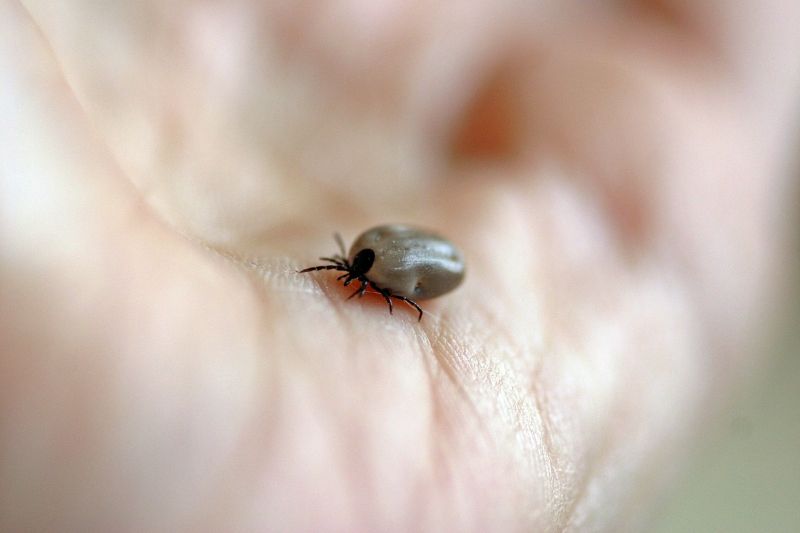Most people assume that ticks primarily live in wooded areas outdoors, like in forests or parks, but these pests can even live in your own backyard.

Identifying Ticks on Your Body
Though all types of ticks have slight variations in their appearance, most have many similarities in regard to their shape, size, and color. Ticks typically grow to be ¼-inch long, though some can grow to be nearly ½-inch long after a full blood meal. These pests tend to be reddish-brown in color and their oval-shaped bodies appear flat until after a blood meal, which is when they become engorged and have a more raised appearance on the surface of your skin.
Because these pests are so small, it can be difficult to spot a tick bite immediately. But early detection is essential, anyone who receives a tick bite is at risk for serious diseases such as:
- Lyme disease
- Rocky Mountain spotted fever
- Southern tick-associated rash illness
- Tick-borne relapsing fever
- Anaplasmosis
- Babesiosis
- Ehrlichiosis
- Tularemia
How to Check Yourself for Ticks
To help protect you and your family from the dangers of a tick bite, perform these steps after spending time hiking, fishing, camping, hunting, or doing any outdoor activity where you may have been exposed to ticks.
1. Do an immediate scanBefore climbing into your car or entering your home, do an immediate, full-body scan for any obvious hitchhiking ticks. Ticks are likely to latch onto areas of your body that may have brushed past their hiding spots, like your wrists, ankles, and legs. Don’t forget to inspect your shoes, too. If someone is with you, check each other’s necks, backs, and back of clothing for signs of these pests. If you do spot a tick on your body, follow the CDC’s guidelines for proper tick removal. Checking for ticks before heading inside can help you avoid bringing any unwanted pests into your home.
2. Perform a more thorough checkPerform a more thorough body inspection once several hours have passed. This can make it easier to spot a tick that has latched onto your body. During this check, it’s essential to fully undress and inspect your body in a full-length mirror to check any hard-to-see areas, like your back and calves. Because these pests prefer warm, dark areas of your body, your armpits, groin, and behind your knees are especially susceptible to tick bites.
If you have long hair, be sure to check the parts of your body your hair covers. Then, check your scalp and behind your ears for any raised bumps that could be an engorged tick. We recommend doing this over a sink or bathtub to prevent the tick from falling onto your clothes or carpet. If any furry friends accompanied you outdoors, perform a similar check on their fur and skin. Pets should be taken to a vet to receive veterinary care if a tick is found and for preventative measures.
3. Inspect your clothesAfter you strip down, place your clothes in a bathtub or shower and give them a good shake to knock off any hiding ticks. Pay extra attention to your socks, shoes, and pant legs. Then, immediately wash and dry your clothes in following the manufacturer’s instructions. The heat will help kill any remaining ticks on your clothes. Repeat this process with any other washable items that may have been exposed to ticks, like picnic blankets and towels.
4. Examine your belongingsBecause ticks are parasites that feed directly on their host, they may be found on items close to their host. This includes clothes, pet fur, bags, and other items that you may come in contact with. Inspect any purses, backpacks, camping gear, or picnic baskets you took with you on your outings, and don’t forget to check the interior of your car for ticks that may be on your car’s seats or floor mats attempting to get to you.
5. Take a showerAfter you perform the above four steps, take a hot shower to wash off any undetected ticks and perform a more thorough check for any pests that could still be hiding in your hair or on your body.
Ticks are small and may not be seen for several days. Even if you feel confident that you removed all possible ticks from your body and belongings, keep a close eye for several days to see if any appear. If you do have to remove any ticks from your body, watch out for any rashes that appear on your body following the bite. The CDC recommends you “see a health care provider if you become sick after a tick bite, have a rash or a fever.”
For help keeping ticks out of your yard year-round, contact Terminix® to get a quote on tick control.


